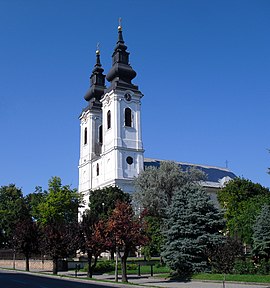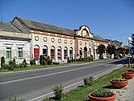Srbobran
Srbobran
Sentomaš | |
|---|---|
Town and municipality | |
Srbobran | |
|
UTC+2 (CEST) | |
| Postal code | 21480 |
| Area code | +381 21 |
| Car plates | NS |
Srbobran (
The municipality of Srbobran encompasses of town of Srbobran, and two villages:
Name
In
History
Archaeological records indicate that there has been human settlement in the territory of present-day Srbobran since
After the Bačka region was captured by Habsburg troops led by Prince Eugene of Savoy in the end of the 17th century, Sentomaš came under Habsburg rule and was populated by new colonists, mainly ethnic Serbs from the south, but also (since the second half of the 18th century) by ethnic Hungarians from the north, who became the second largest ethnic group in the settlement (after Serbs). The settlement was part of the Military Frontier until 1751, when it came under the civil administration. A document from 1751 indicates that besides the name Sentomaš, Srbograd ("Serb Town") was also used as an unofficial name for the town. The town grew quickly; in 1787 its population was 3,532, while in 1836 this number rose to 11,321. After 1751 the town was part of the Theiss district within Batsch-Bodrog County and the Habsburg Kingdom of Hungary.

The name Srbobran dates from the time of the
Sentomaš became part of the
Demographics

Ethnic groups in the municipality
According to the 2011 census, the population of the Srbobran municipality is composed of:[7]
- Serbs = 10,703 (65.63%)
- Hungarians= 3,387 (20.76%)
- Romani = 629 (3.85%)
- Others and undeclared = 1,598 (9.79%)
All of the three settlements in the municipality have an ethnic Serb majority. The Serbian and Hungarian language are officially used by municipal authorities.[8]
Also see:
Ethnic groups in the town
In 2011, Srbobran town has a population of 12,009, including:[7]
- Serbs = 7,093 (59.06%)
- Hungarians = 3,220 (26.81%)
- Roma = 465 (3.87%)
- Others and undeclared = 1,231 (10.25%)
Historical population of the town
- 1961: 14,391
- 1971: 14,189
- 1981: 13,596
- 1991: 12,798
- 2011: 11,968
Economy
The following table gives a preview of total number of employed people per their core activity (as of 2017):[9]
| Activity | Total |
|---|---|
| Agriculture, forestry and fishing | 427 |
| Mining | 18 |
| Processing industry | 459 |
| Distribution of power, gas and water | 61 |
| Distribution of water and water waste management | 48 |
| Construction | 106 |
| Wholesale and retail, repair | 465 |
| Traffic, storage and communication | 135 |
| Hotels and restaurants | 77 |
| Media and telecommunications | 12 |
| Finance and insurance | 20 |
| Property stock and charter | 2 |
| Professional, scientific, innovative and technical activities | 89 |
| Administrative and other services | 43 |
| Administration and social assurance | 176 |
| Education | 190 |
| Healthcare and social work | 176 |
| Art, leisure and recreation | 23 |
| Other services | 77 |
| Total | 2,604 |
Transport
Town is located near to the M22 motorway between Belgrade and Subotica. There are two national highways that run through the town, highways 3 and 22. These three important routes make the town an important transport link.
Highway 3 runs west to Sombor, and east to Bečej. Highway 22 runs to Budapest in Hungary to the north changing to Highway 5 in Hungary, and to Ribarice, in the south of Serbia.
Architecture
There are two notable buildings in Srbobran, both of which are churches (one is
Famous citizens
- Members of the wealthy Dunđerski family were buried in the town's cemetery, including the famous beauty Lenka Dunđerski, who was a tragic love of poet Laza Kostić.
- Srbobran is the birthplace of Nándor Gion (1941–2002), one of the best-known Hungarian writers, who was born and mostly lived in the region of Vojvodina. In his books he describes, first of all, his home-town, "Szenttamás", during the tragic years of the world wars.
- Đorđe Dunđerski, Yugoslavian tennis player
- Ognjen Mudrinski, football player
- Aleksandar Katai, footballer, member of the Serbia national football team
- Stefan Bukinac, footballer, member of the Serbia U19 national football team
- Laszlo Vegel[10]
- Aleksa Orlović Serbian programmer
Gallery
-
Oil drilling facilities near Srbobran
-
Catholic Church
-
Monument Sloboda (Liberty) in central park of Srbobran
See also
- List of places in Serbia
- List of cities, towns and villages in Vojvodina
- Municipalities of Serbia
- South Bačka District
Notes and references
- Notes
- Slobodan Ćurčić, Broj stanovnika Vojvodine, Novi Sad, 1996.
- Slobodan Ćurčić, Naselja Bačke - geografske karakteristike, Novi Sad, 2007.
- References
- ^ "Председник општине Србобран РАДИВОЈ ДЕБЕЉАЧКИ". Srbobran Official website. Retrieved 3 April 2018.
- ^ "Municipalities of Serbia, 2006". Statistical Office of Serbia. Retrieved 2010-11-28.
- ISBN 978-86-6161-109-4. Retrieved 2014-06-27.
- ^ Општина Србобран: Локална самоуправа (in Serbian). Municipality of Srbobran. Retrieved 2013-02-06.
On the territory of the Municipality in official use are Serbian language and Cyrillic script and Hungarian language and script
- ^ "Srbobran Map and Weather Forecast". Worldplaces.net. Retrieved 2017-08-28.
- ^ "CSERES TIBOR: VÉRBOSSZÚ BÁCSKÁBAN". Vmek.oszk.hu. Retrieved 2017-08-28.
- ^ a b "Population by ethnicity – Srbobran". Statistical Office of the Republic of Serbia (SORS). Retrieved 4 March 2013.
- ^ "Statut opštine Srbobran" (PDF), Ombudsman.rs (in Serbian), p. 1, 8 July 2008
- ^ "ОПШТИНЕ И РЕГИОНИ У РЕПУБЛИЦИ СРБИЈИ, 2018" (PDF). stat.gov.rs (in Serbian). Statistical Office of the Republic of Serbia. Retrieved 17 March 2019.
- ^ Laslo Pašćik (1971). Živan Milisavac (ed.). Jugoslovenski književni leksikon [Yugoslav Literary Lexicon]. Novi Sad (SAP Vojvodina, SR Serbia: Matica srpska. p. 558.











